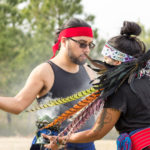
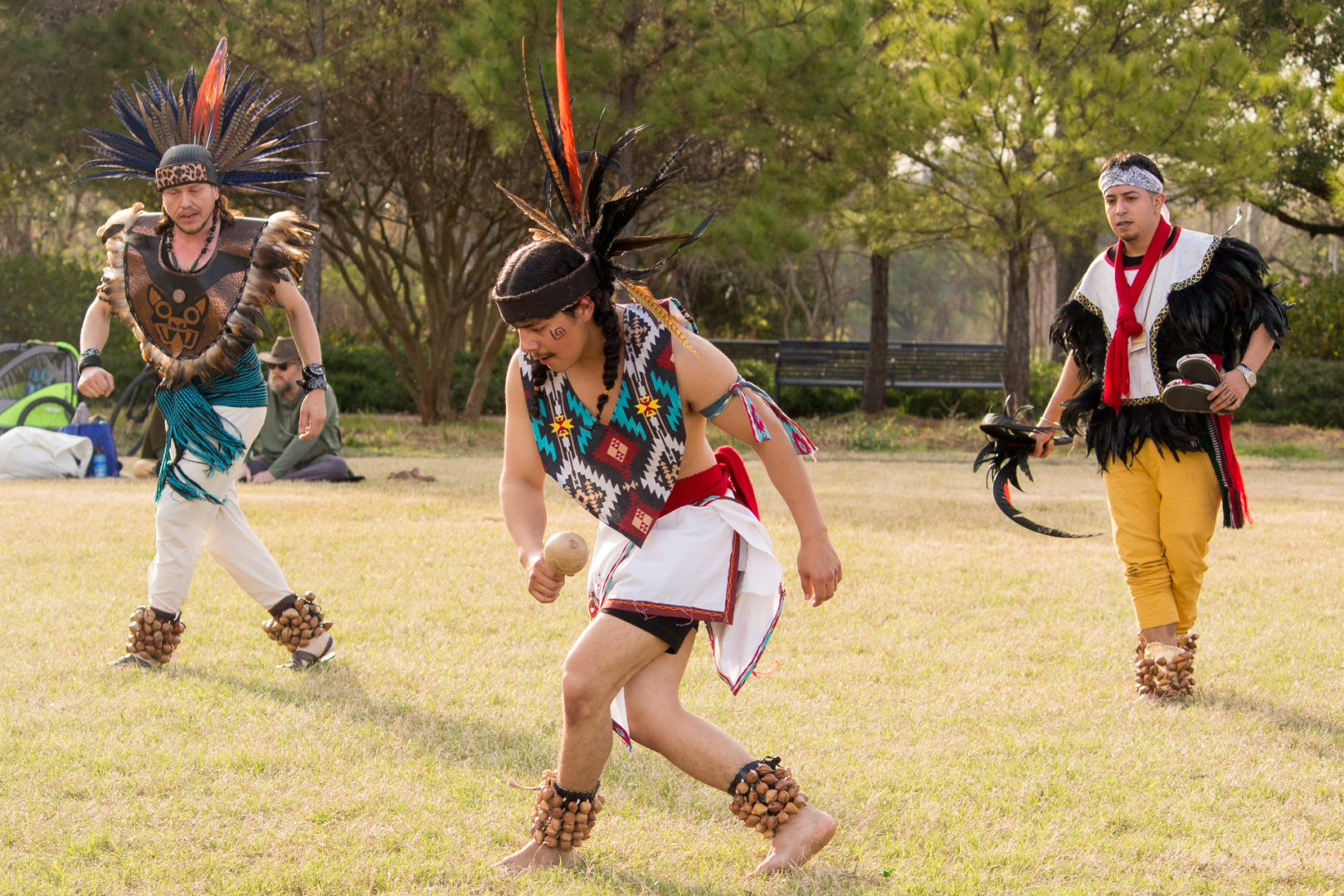
Jesus Navarro (left), Mauricio Turrubiartes III (center) and Uriel Garcia-Vega (right) of the Houston Aztec Dance group partake in a traditional dance ceremony to honor the last Mexica-Aztec tlatoani-leader Cuauhtémoc. The group meets weekly to learn the Aztec traditions and ceremonies as a way to reconnect with their indigenous heritage. | Katrina Martinez/The Cougar
There are an estimated 70,000 Native Americans who call Houston and its surrounding areas home, but there have been little to no services, centers or programs geared toward the needs of natives in the fourth largest city in the country.
To fill the void, the Tunica-Biloxi Tribe of Louisiana, which has about 400 of its 1,200 enrolled tribal members living around Houston, opened the new American Indian Center of Houston in late February with their goal to help the underserved Native American population that lives in the Houston area.
“They’ve been here,” said Nikki McDonald, the director of the new center and Tunica-Biloxi tribal member who has lived in the area for about 10 years. “They’ve asked for help. They haven’t been able to receive help. It’s almost kind of — I don’t want to say — a slap in the face, but there’s so many programs to help other communities, but I haven’t seen that program for Native Americans yet.”
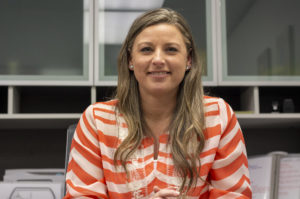
Nikki McDonald is the director of the new American Indian Center of Houston. She is a Tunica-Biloxi tribal member who has lived in the Houston area for about 10 years. | Katrina Martinez/The Cougar
The center, which hopes to provide things like health services, mental health support, substance abuse rehabilitation, a fitness center, mentorship programs and community events in the future, was conceived after Tunica-Biloxi tribal councilmembers found Houston had such a large and underserved population of Native Americans.
“We started looking at what programs and services are available for Native Americans in the Houston area,” McDonald said. “There’s not really a whole lot. Houston is the fourth-largest city in the United States of America, and we have a population of 70,000 (natives). We have to do something about that.”
McDonald hopes to grow the center into one like those in Dallas or Oklahoma, which both have large inter-tribal centers that have served natives for many years.
They have even partnered with the Alabama-Coushatta Tribe, which is based out of Livingston, to provide more to the native community. The hope is to create a hub where all Native Americans can turn to for assistance and services, McDonald said.
Despite the size of the Native American population in southeast Texas, there are no native reservations and no subsequent services available, but this is nothing new to those who live here.
For instance, the closest office for the Bureau of Indian Affairs, which aims to improve the quality of life, provide more economic opportunities and protect Native Americans, is in Anadarko, Oklahoma. That is about a 460-mile drive for Houston-area Native Americans.
Additionally, the Indian Health Service, whose mission is to “raise the physical, mental, social, and spiritual health of American Indians,” does not have any facilities or area headquarters in Texas.
As an ethnicity, according to the Kaiser Family Foundation, Native Americans are most likely to lack health insurance, to be diagnosed with diabetes and cardiovascular disease, second-most likely to suffer from mental health issues and the most likely to live in poverty. Yet these essential health and wellness programs are not universally available to Native Americans.
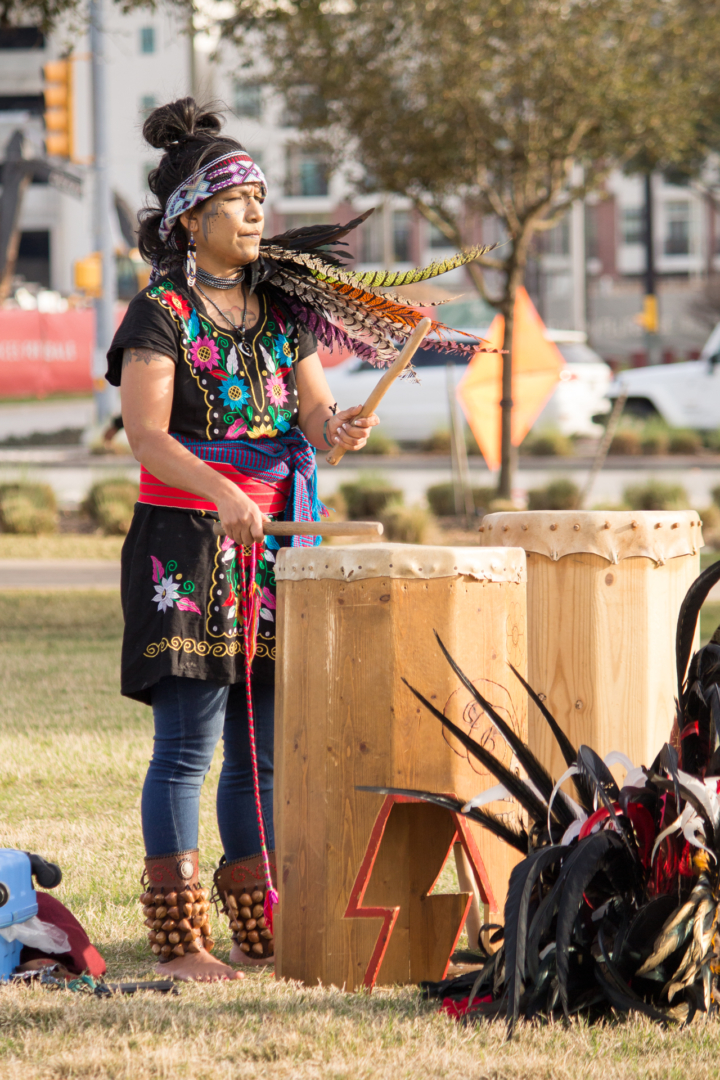
Abuela M’api leads the Houston Aztec Dance group in their traditional dance by playing the drums. As a way to spread her culture she teaches free Aztec dance classes at Moody Park. | Katrina Martinez/The Cougar
“We’re not from the res(ervation),” said Abuela M’api who is the Temachtiani, or guide, of the Houston Aztec Dance group. “We’re generationally here from Texas, and Texas has never had BIA here or Indian Health services.”
Cultural resurgence
While the American Indian Center of Houston works to improve the livelihoods of Native Americans, the Houston Aztec Dance group, or Calmecac Tonantzin Yolilitzyotl, aims to unite the native peoples and encourage a resurgence of native culture and traditions.
The Calmecac is a group of about 40 people who meet regularly, practice traditional Aztec dances and ceremonies and showcase their heritage throughout the city of Houston.
Most recently on Feb. 22 the group had the First Wind Ceremony, or Primer Viento, which was to honor Cuauhtémoc, the last Mexica-Aztec tlatoani-leader. As part of the ceremony, they burned sap, sounded conch shells, played the drums and performed traditional dances in Buffalo Bayou Park as a group.
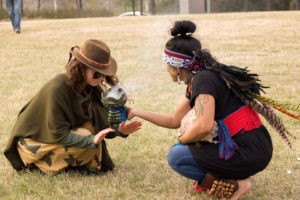
Abuela M’api invites ceremony spectators to participate in the ceremony and uses a burning sap to cleanse them before partaking in a prayer circle. Abuela M’api teaches the Aztec dances and traditions while allowing anyone to join the group. | Katrina Martinez/The Cougar
Houston Aztec Dance is inclusive in the sense that not only did they allow park-goers to watch their ceremony, they also allowed them to take part in certain traditions and a prayer circle.
The group was started by Abuela M’api, who trained under elders in Mexico and brought the practices back to Houston to share with those who wanted to learn. She has even brought group members to schools to perform for and educate kids about Aztecan traditions.
“I was basically being assimilated into American culture and not being told anything other than I was Mexican American,” Abuela M’api said. “I was really disconnected from my roots in Mexico. I was disconnected from my indigenous lineage here in Texas, and we were just being raised Hispanic.”
Identifying as indigenous
For people like Abuela M’api, who was raised as a Mexican American despite her indigenous lineage, it is common not to identify as Native American, which can make it difficult to get an accurate estimate of the native population.
For instance, by the U.S. Census standards, there are roughly 11,000 Native Americans in the Houston area, according to Mark Fossett, the executive director of the Federal Statistical Research Data Center in College Station.
But McDonald’s estimate of 70,000 is a “more inclusive definition of Native American,” which is better in some cases but not how the Census operates, Fossett said.
“Many, many people have significant claims to Native American ancestry and heritage,” Fossett said. “But only some of them will identify as Native American in the Census.”
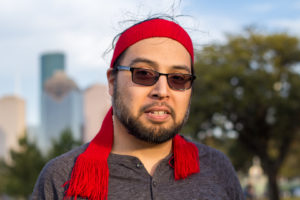
Jason Colunga, a 2005 UH alumnus, joined Houston Aztec Dance as a dancer about two years ago. He enjoys dancing in the Calmecac and uses this experience as a way to learn about his indigenous heritage. | Katrina Martinez/The Cougar
Member of the Houston Aztec Dance group and 2005 UH alumnus Jason Colunga said he was never allowed to learn about his indigenous heritage.
To protect him from the treatment they received when they were younger, Colunga said his parents chose not to teach certain things like how to speak Spanish.
As a Latino, Colunga said he is Native American because his family is indigenous to North America and has found a way to celebrate that heritage by dancing in the Calmecac.
“Our people, they come from all over the Americas,” Colunga said. “There’s been such a disconnect and that’s something that we don’t get taught much in public schools, even some colleges really gloss over it.”
Colunga wishes UH would do more to educate students about Native American heritage and believes inter-tribal organizations would be a great start.
“I think having a group like (the Calmecac) on campus is a great way to unite people,” Colunga said. “Even though it may be different tribes, we’re all a part of the same culture. No matter what part of the Americas, there’s a lot to be shared and learned throughout.”
The University has seen a near 50 percent loss of enrolled Native Americans in the last 10 years, which is not necessarily representative of the surrounding community. Fossett said despite the indigenous population being a small one in the Houston area, he doesn’t expect the number to change very much with the upcoming 2020 Census.
This means, although the number of Native Americans in the Houston area are expected to remain the same, UH is still losing significant amounts of Native American enrollment. Colunga feels this can be detrimental to those who hope to learn more about their heritage when they go to college.
“For those students that aren’t a part of (cultural groups),” Colunga said, “it’s something that stays lost.”
news@thedailycougar.com
—
“New Native American center opens to serve Houston’s underserved indigenous community” was originally posted on The Daily Cougar
